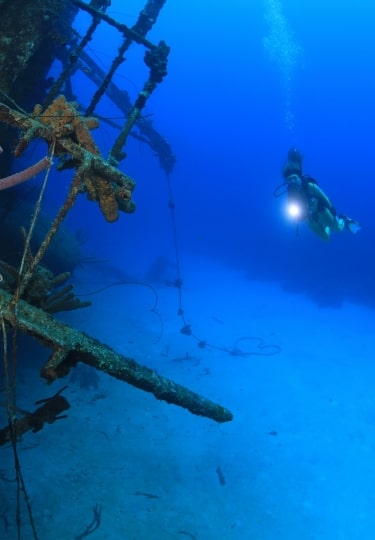Completely encircled by a fringing coral reef, there are plentiful opportunities to go scuba diving in Bonaire. In fact, there are more than 85 dive sites here, some 54 of them accessible from the shore.
Thanks to the island’s consistently pleasant tropical climate and warm, crystal-clear aquamarine seas, you can dive here year-round.
The entire area around Bonaire is protected as a marine park and encompasses dazzling corals, seagrass beds, and mangroves. Diving in Bonaire is a chance to explore gently shelving slopes, vertical walls, wrecks, and shallow plateaux. The range of species here is spectacular, with more than 350 types of fish and 57 different corals.
These are some of the best places to explore Bonaire’s underwater world.
1,000 Steps
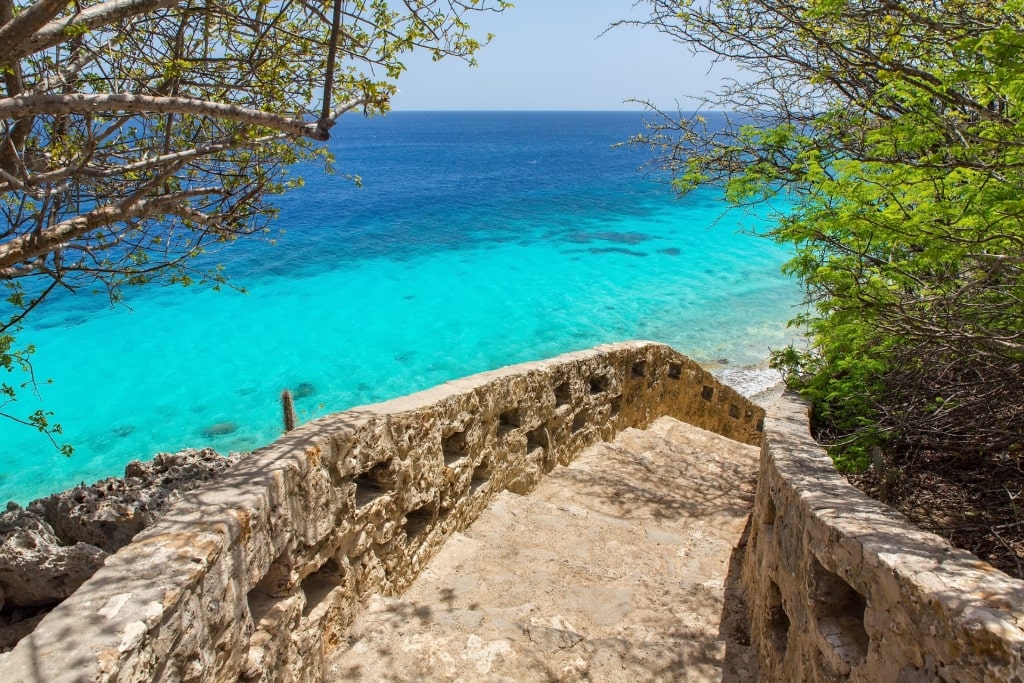
1,000 Steps
This popular site, located on the island’s west coast, is accessed by 67 steps that lead from the parking area to the beach. Because you have to carry your gear back up the steps, it’s been nicknamed 1,000 Steps, as some say that’s how it feels.
Nevertheless, the diving here is spectacular. The beach drops off into a reef teeming with an extraordinary range of species, including towering formations of star coral. These pagoda-like formations have hollow cores where reef creatures seek protection and lay their eggs.
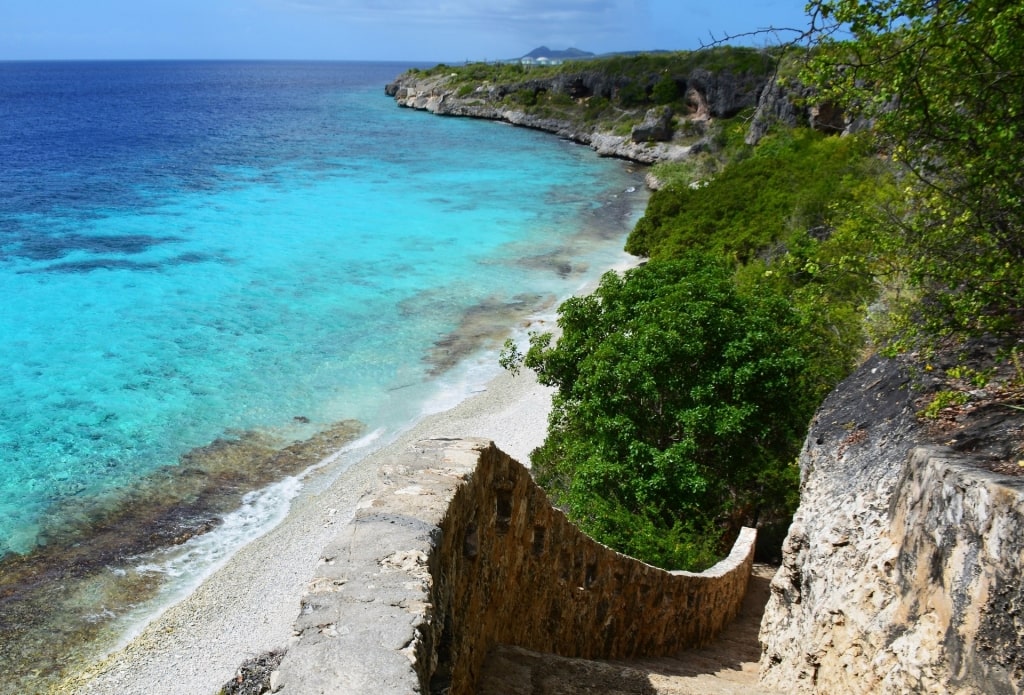
1,000 Steps
You could see turtles, moray eels, and beautiful manta rays gliding through the blue depths, and—if you’re lucky—enormous whale sharks. Whale sharks are harmless filter feeders and present no threat to divers or snorkelers.
Bonaire is also one of the best islands in the world for snorkeling, and the 1,000 Steps dive site has potential for snorkelers, too. There are thriving patches of staghorn coral close to the beach, just 10 feet down, around which parrotfish, butterfly wrasse, and surgeonfish flit.
Hilma Hooker
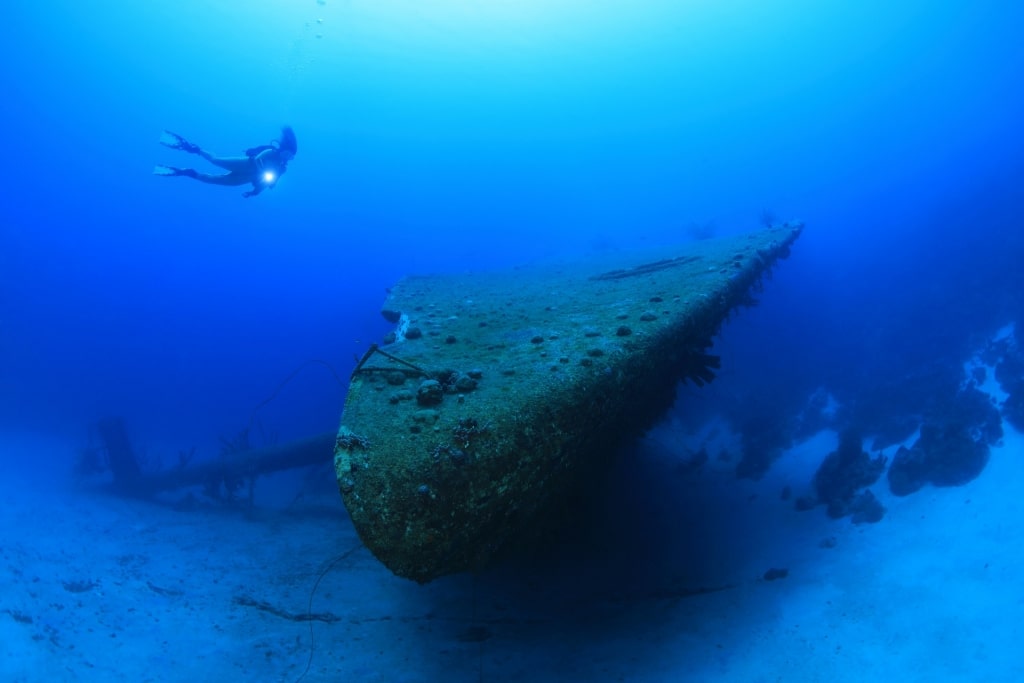
Hilma Hooker
The Hilma Hooker, the wreck of a former drug-running boat, lies in 60 to 99 feet of clear water off Bonaire’s southwest coast. It’s created a magnificent artificial reef and is one of the most popular locations for scuba diving in Bonaire.
Dozens of species of fish have colonized the wreck, including barracuda and tarpon, lionfish, eagle rays, and stingrays. Spiny lobsters hide out under the masts and in the cargo holds.
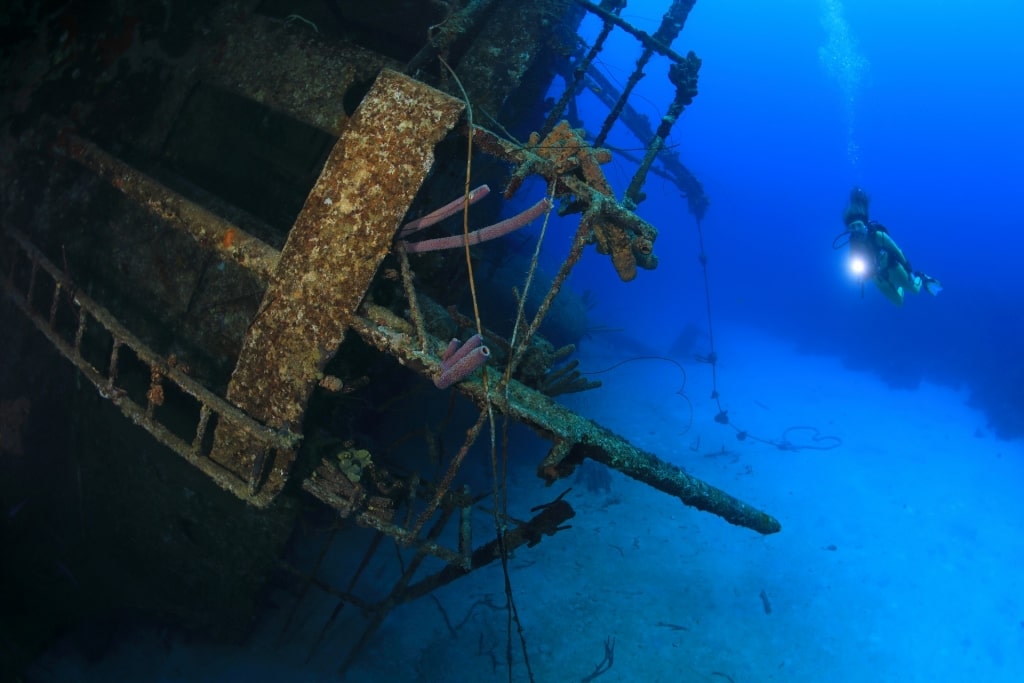
Hilma Hooker
The Hilma Hooker is well known in the diving community, and as such, is a popular spot. Most dive leaders will take you by boat or underwater from the beach, as it’s a long swim on the surface. A guide is essential if you want to go inside the wreck; this is one for more experienced divers.
Read: Best Beaches in Bonaire
Alice in Wonderland
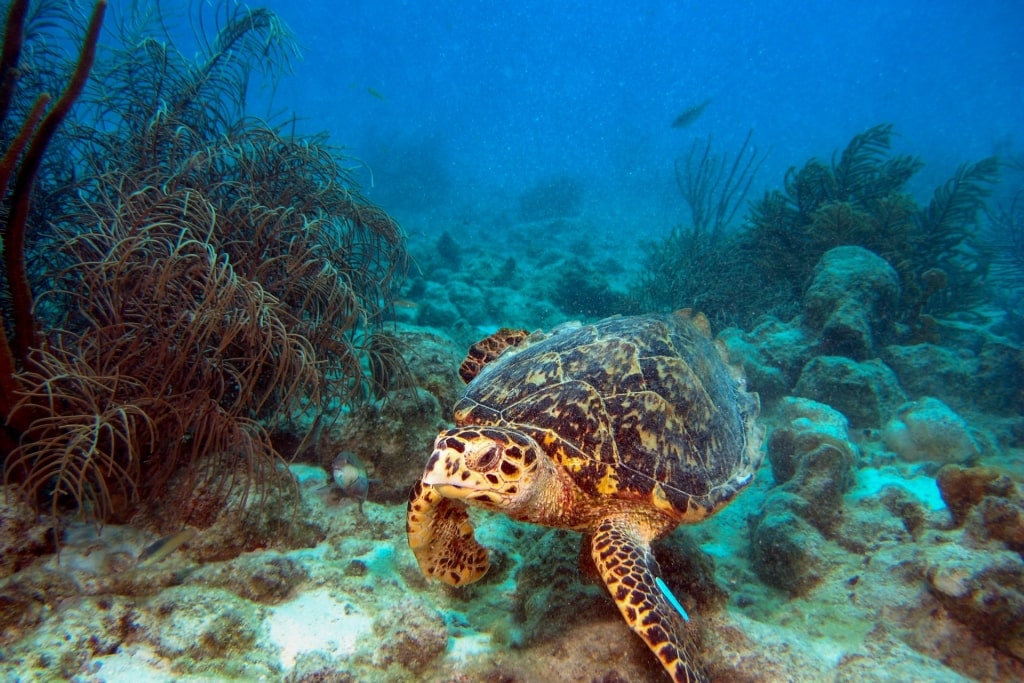
Alice in Wonderland
Located in the southwest of Bonaire near the salt flats, the Alice in Wonderland dive site is a double reef in depths of 30 to 100 feet, colonized by multiple corals—brain, star, leaf, and fan—which gives it a wonderful three-dimensional perspective.
You will need a compass and an experienced dive leader to cross to the second, much deeper reef, where you’ll spot barracuda and triggerfish, as well as moray eels. But there’s plenty to see among the corals on the first reef, too, if you prefer a shallower, or longer dive.
Read: Top Things to Do in Bonaire
Bari Reef
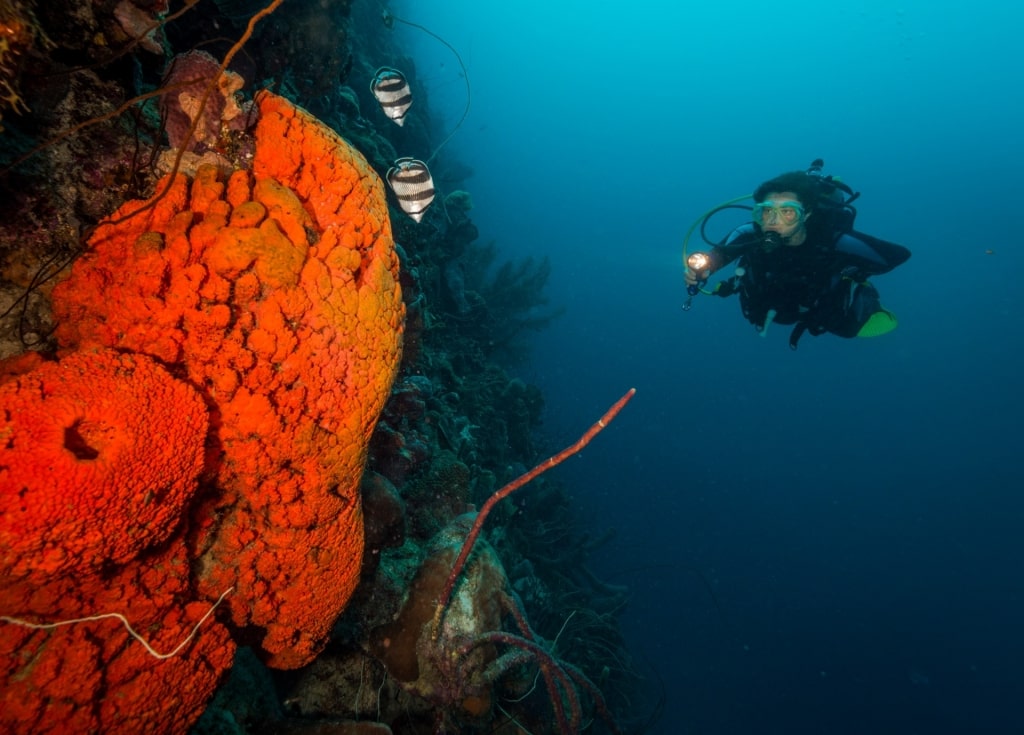
Bari Reef
Close to Kralendijk, Bari Reef has been voted best in the entire Caribbean for its diversity of marine life, with more than 300 species of fish logged. It’s certainly regarded as one of the best places to go diving in Bonaire.
You can enter the water from the beach here, with the best underwater viewing from 30 to 100 feet down. Snorkelers can swim around the stands of coral in the shallows, too, for colorful viewing.
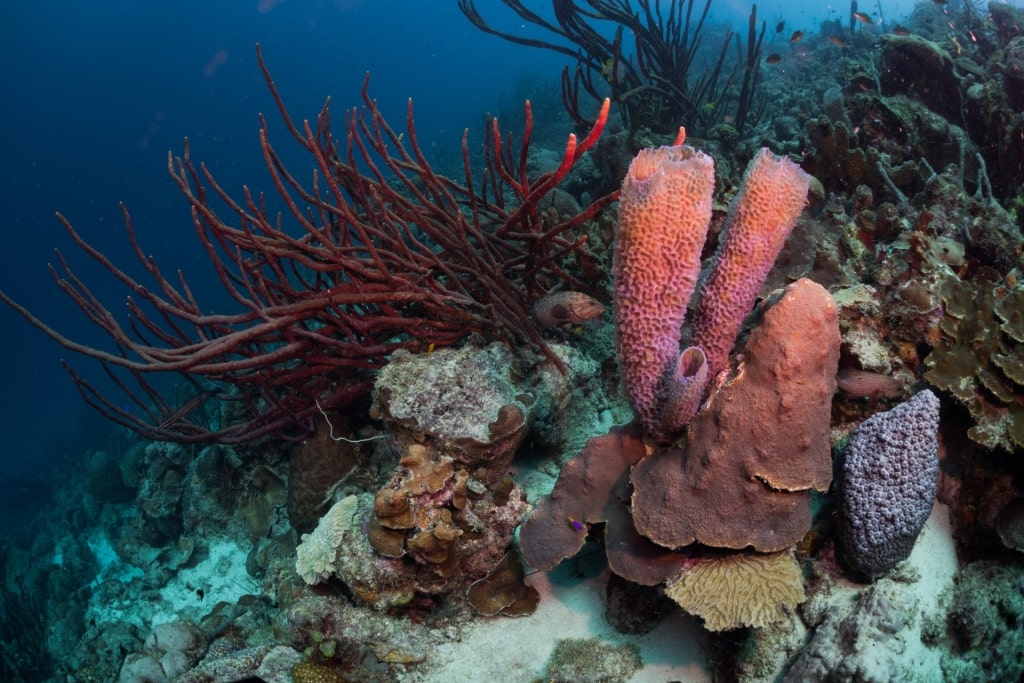
Bari Reef
Check out the jetty to the north of the beach, where all sorts of fish seek protection. As you explore the reef, you could see octopus, barracuda, tarpon, shrimp, goatfish, gobies, crabs, and spiny lobster.
Look out for the yellowhead jawfish, a pearly-colored fish with a yellow head that carries its eggs in its mouth. You could spot frogfish, too, which are lumpy-looking creatures that do indeed bear a resemblance to a frog.
As well as fish, the reef is populated by sponges in shades of scarlet, yellow, and electric blue.
Karpata
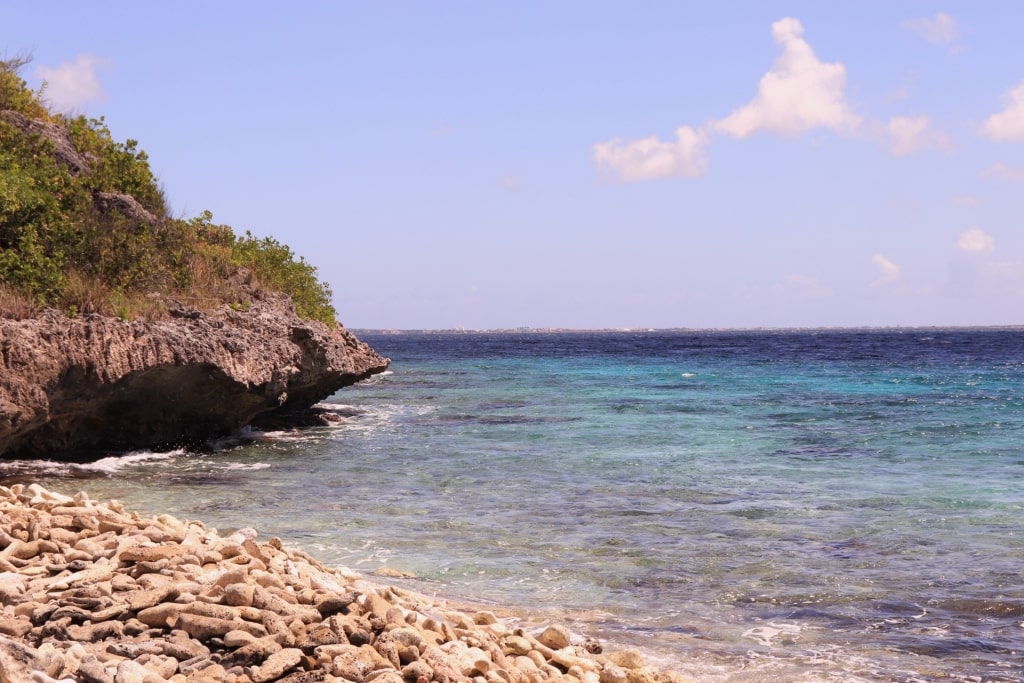
Karpata
Off the island’s northwest shore, Karpata is famed for its dazzling elkhorn coral. Some specimens are several feet tall and remarkably close to the surface.
The water here is exceptionally clear, and there’s a sizable population of resident sea turtles. You’ll also find a collection of old ships’ anchors scattered across the seabed, which are now encrusted with life. This is a great spot to look for blue tang, parrotfish, angelfish, and perch, as well as turtles.
The entrance to the water on the rocky shore is from a concrete platform, also used by snorkelers. If you prefer to snorkel or free dive, there’s plenty to see as you approach the drop-off, where the reef stretches away at depths of six to 12 feet before falling into the depths. You do need to be a strong swimmer, though.
Salt Pier
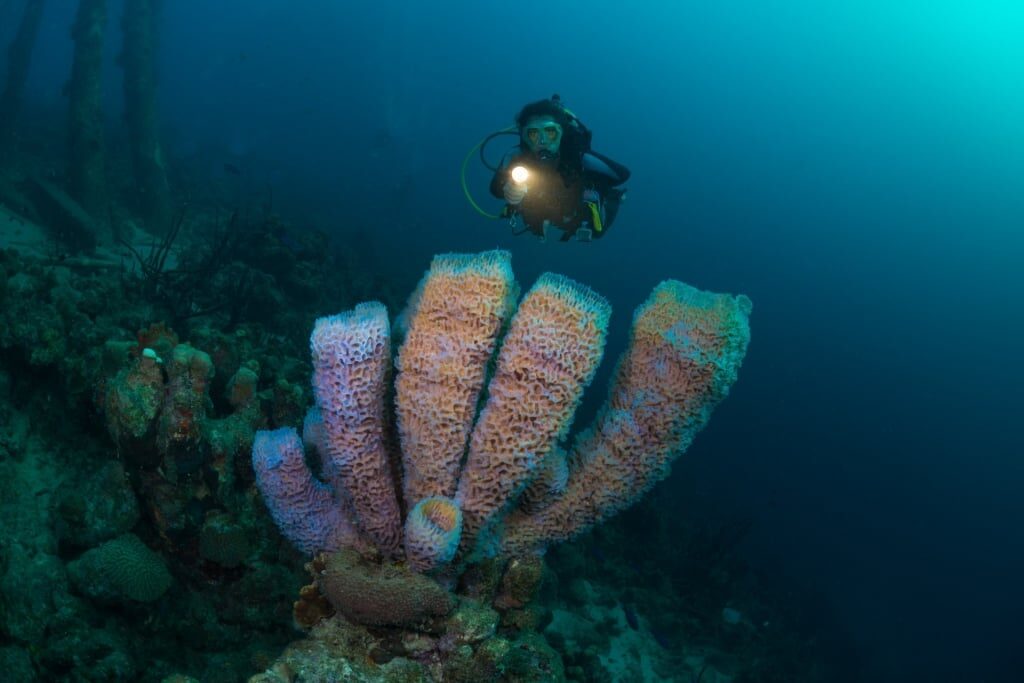
Salt Pier
A long pier jutting out from the salt flats in the island’s southwest, Salt Pier is a great spot for relatively inexperienced divers. There’s a lot to see in the shallower water around the sponge and coral-encrusted pillars of the pier.
Large schools of fish congregate in the shade of the pier, from barracuda to tarpon and frogfish. Octopuses are common here, as are moray eels, crabs, and shrimps. Look out for sea turtles which feed on the sea grass that covers the sandy ocean floor, rippling gently in the current.
Witches Hut/Weber’s Joy
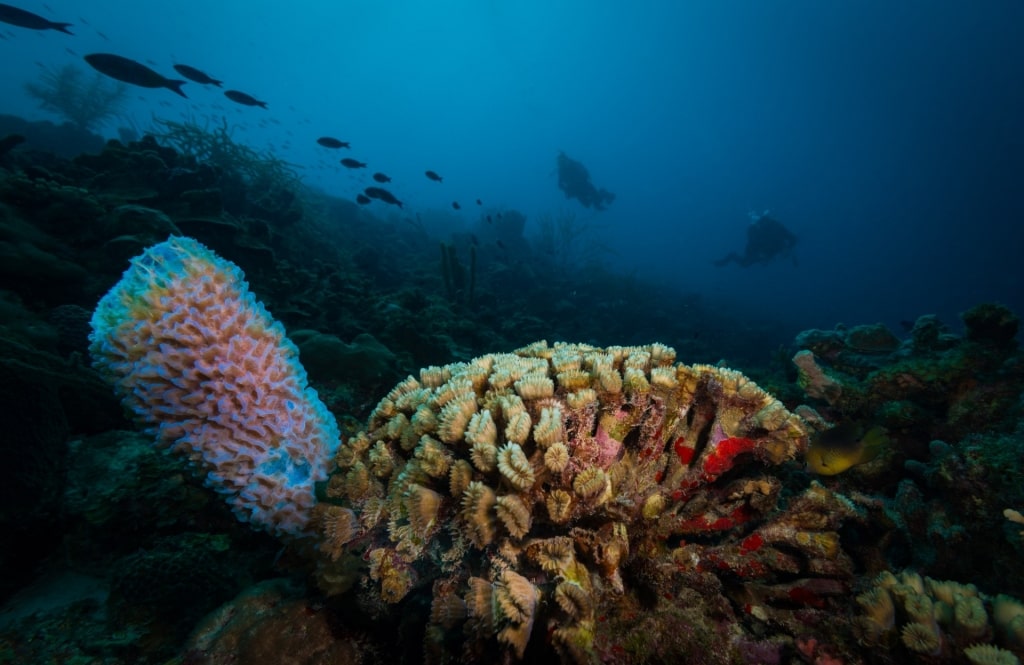
Weber’s Joy
Weber’s Joy, also known as Witch’s Hut after a small hut that once stood on the beach, is a popular dive site on Bonaire’s west coast. There are brilliantly colored sponges here, as well as corals, with marine life including squid, octopus, and the ubiquitous parrotfish, which you can hear munching on the coral.
You enter the water here from the beach and simply swim out to the reef, which drops off steeply to around 80 feet. Despite this depth, Weber’s Joy is a calm, straightforward dive for the less experienced.
Andrea 1 & 2
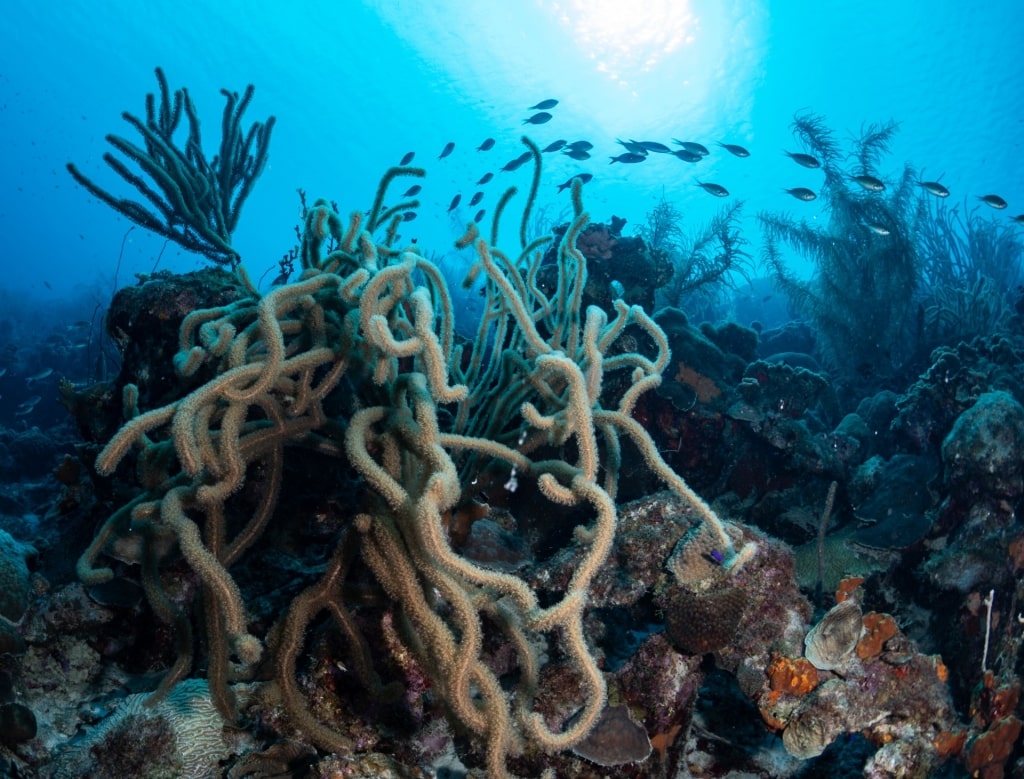
Andrea 1
Andrea I and II are two adjacent dive sites on Bonaire’s west coast, suitable for beginners and snorkelers as well as more advanced divers. You’ll see the whole visible spectrum of color in the anemones and soft corals here.
There’s a good chance of spotting seahorses, too. Three species of parrotfish, some more than three feet long, munch on the corals in the shallows. You could also spot dazzling blue tang, moray eels, and sea turtles.
Andrea II, a short distance to the north, is famed for its coral, at its most beautiful from around 18 to 60 feet. Look out for brain coral, plate coral, and staghorn coral, all of which attract shoals of fish. Shy seahorses take refuge among the soft corals and are a prized sighting.
Both divers and snorkelers enter the water from the beach here. You’ll need to swim out over a shallow plateau littered with dead coral before reaching the main attraction.
Margate Bay
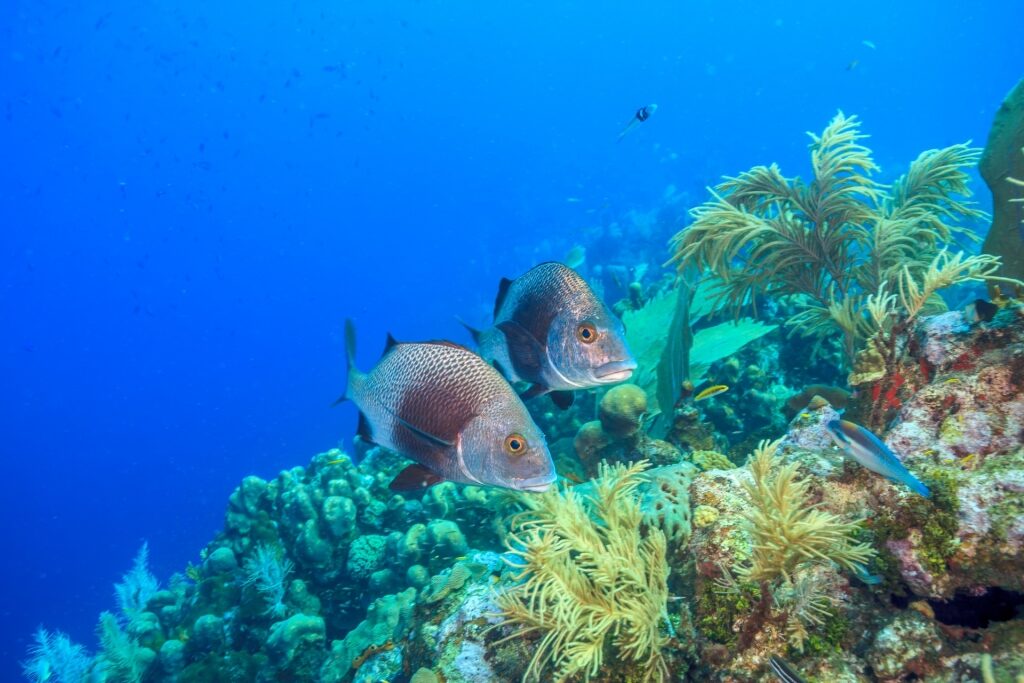
Margate Bay
Located off the salt flats in the far south of the island, Margate Bay takes its name from the resident school of black margates here, also known as bream, or grunt.
You’ll enter the water from the beach and head out over the sand flats to depths of between 24 and 65 feet, where there’s abundant coral. Parrotfish, surgeonfish, striped red mullet, turtles, and eagle rays gather here.
Once you’re back on dry land, look out for the brilliant pink of the flamingos on the salt flats, shimmering like a mirage in the heat haze.
The White Hole/Turtle City
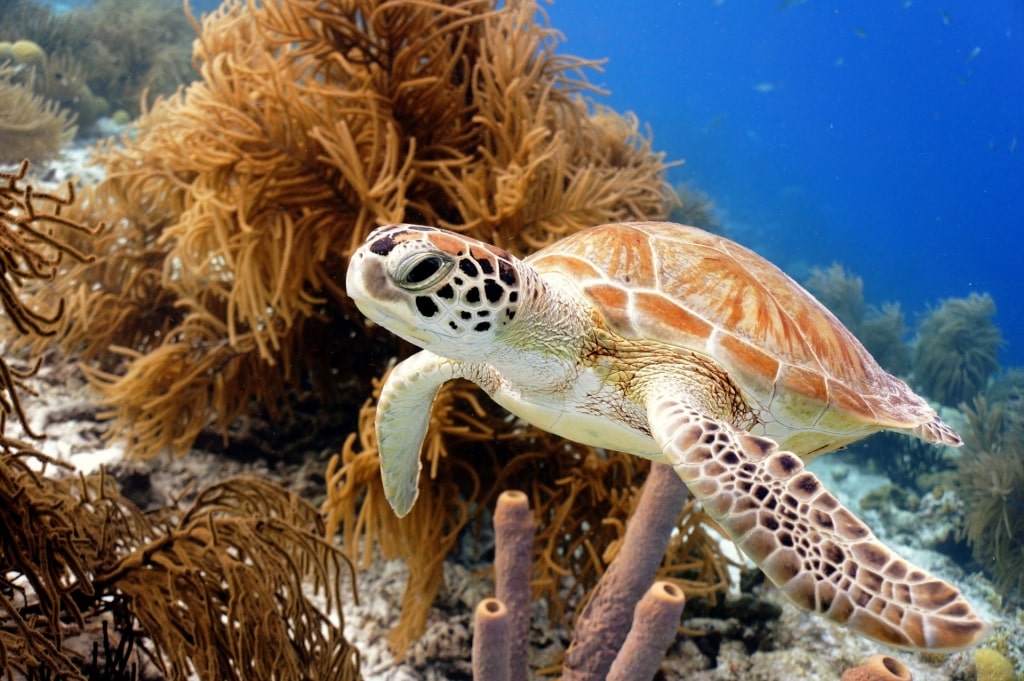
Sea turtle
There’s a clue in the name of this east coast dive site at the entrance to Lac Bay, a vast expanse of turquoise shallows marbled with swirls of white sand.
Thanks to the abundance of seagrass on the ocean floor, you’re pretty well guaranteed to see dozens of sea turtles here, feeding, drifting through the blue, or popping up to the surface to breathe. Tarpons, rays, and, very occasionally, sharks frequent the site, too.
To reach the White Hole, a soccer field-sized patch of sand lying 40 feet down outside the reef, you’ll need to join a boat dive.
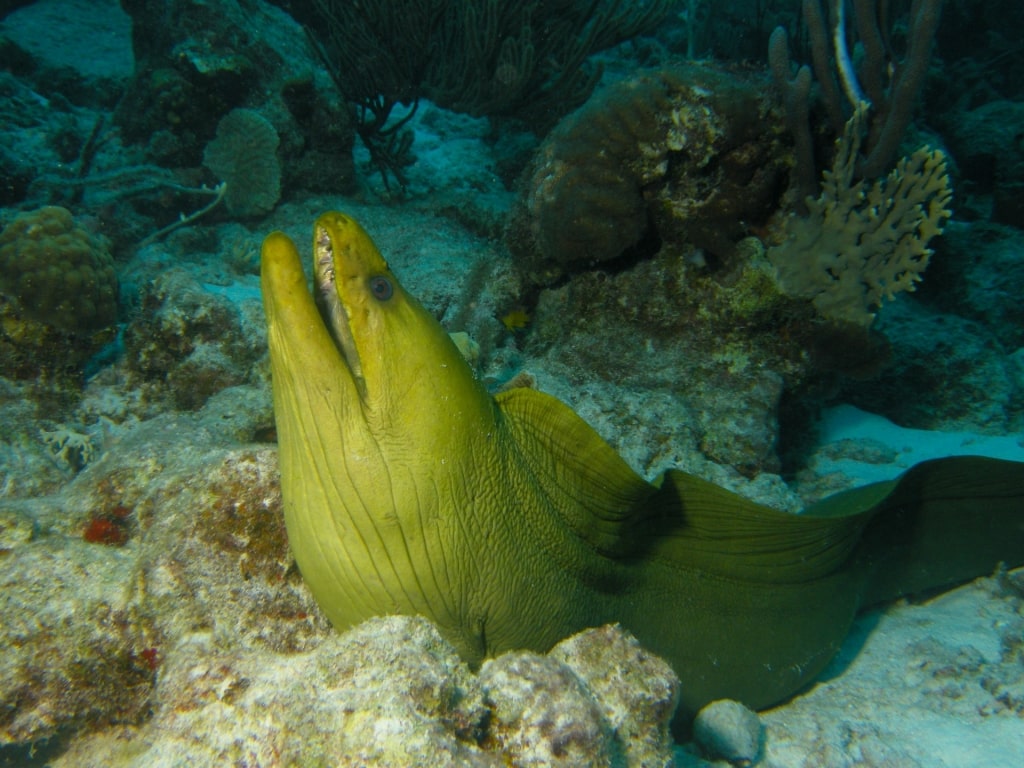
Green moray eel
This is a great opportunity to dive a wall in relatively shallow depths, on the lookout for green morays resting on the coral ledges. You could also see schools of snappers and grunts, black grouper, queen conch edging across the sand, and possibly buried stingrays, their eyes just visible.
Bruce’s Rappel
Located between the 1,000 Steps and Karpata sites, Bruce’s Rappel is known for its steep cliffs that plunge into the sea and continue underwater. It’s named after the late Bruce Bowker, the first professional diving instructor in Bonaire.
In the early days, daredevil divers would attempt to enter the water by rappelling down the cliff, holding onto a rope, in all their gear. Today, there’s no need, as dive operators will take you to Rappel by boat.
You’ll find yourself amid a world of magnificent coral gardens tended by all manner of small, rainbow-colored fish as well as larger grouper. You could spot lobsters scuttling across the seabed, too.
Carl’s Hill
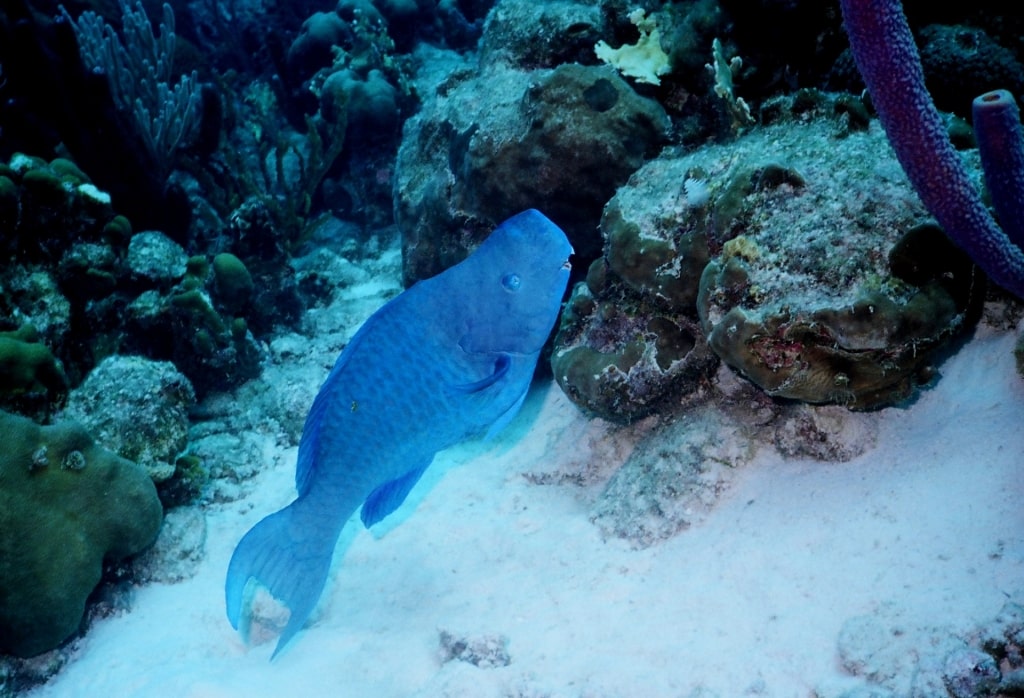
Blue parrotfish
No dive trip to Bonaire would be complete without at least one dive from the uninhabited island of Klein Bonaire, just off the west coast of Bonaire itself.
Klein Bonaire is part of the Bonaire National Marine Park, one of the best diving spots in the world, and is home to turtle nesting grounds. You’ll see a lot of day boats bringing snorkelers to enjoy the shallow reefs, and the peace and quiet.
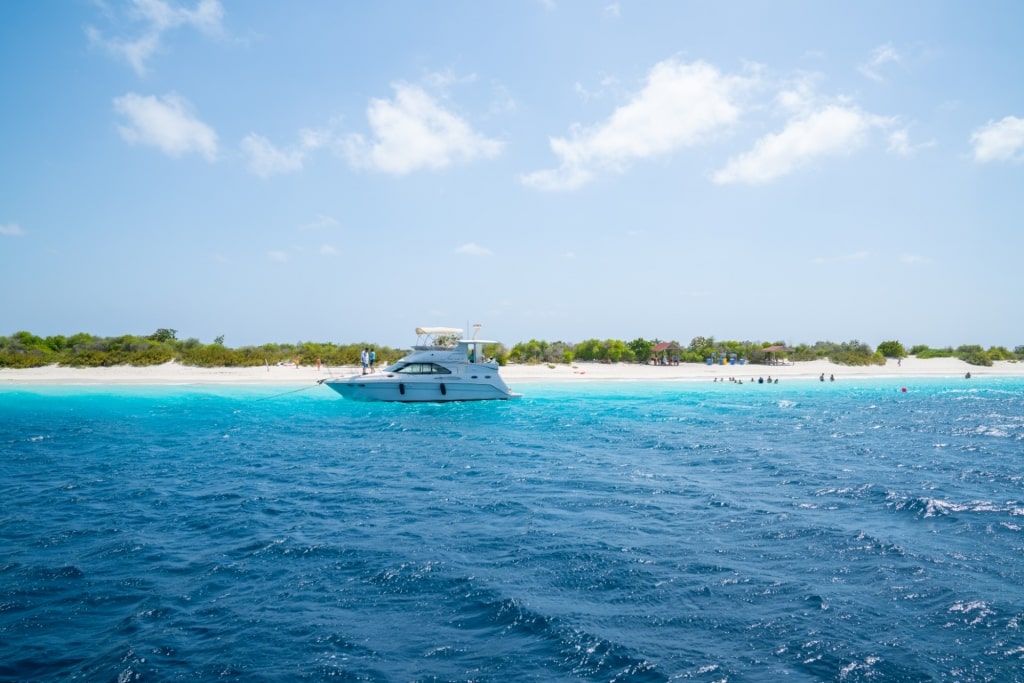
Klein Bonaire
To protect the coral here, scuba diving is restricted around Klein Bonaire during certain hours, but it’s certainly worth trying to get in one dive while you’re here.
Carl’s Hill is a wall that slopes down from around 30 feet to 120 feet, alive with scarlet and yellow sponges and delicate soft corals teeming with jewel-like fish. Look out for blue parrotfish, surgeonfish, barracuda, and blue tang. You may spot seahorses, too.
Read: Best Spots for Scuba Diving in the Caribbean
Something Special
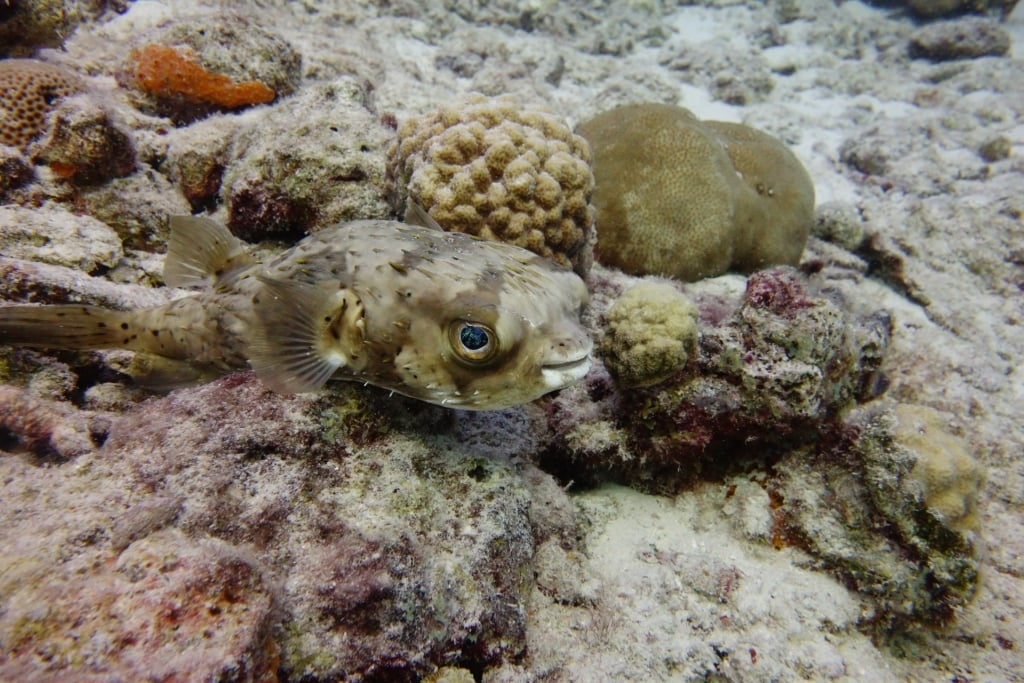
Something Special
This dive site near Kralendijk gets its name from its impressive biodiversity. Healthy corals in dazzling colors attract everything from seahorses to scorpionfish, crab, lobster, and sea anemones. You can reach the site, which is marked by a yellow buoy, from the beach.
This dive site is known for its cleaning stations, areas of the reef populated by wrasse and shrimp that offer a “service” to larger fish by “cleaning” them of external parasites. Watching one of these fishy spas in action is fascinating.
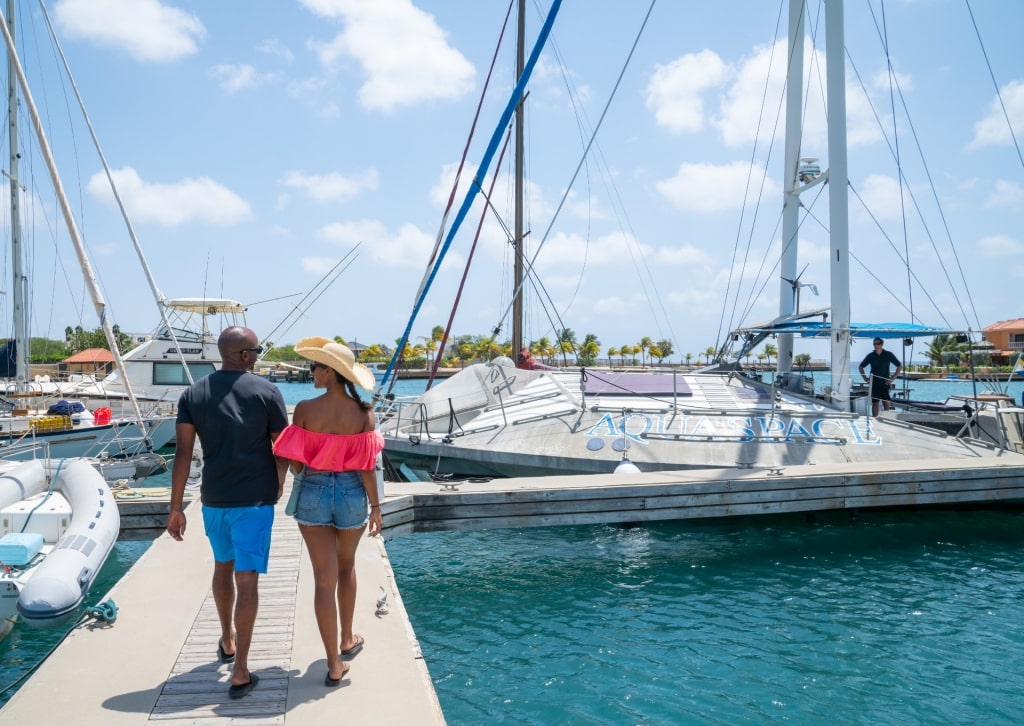
Bonaire
Are you tempted by this beautiful island’s magnificent underwater world? Then browse our Bonaire cruises, pack your diving logbook and your reef-friendly sunscreen, and book your next adventure.
